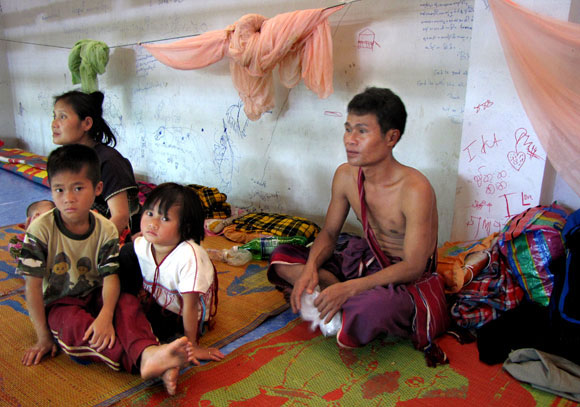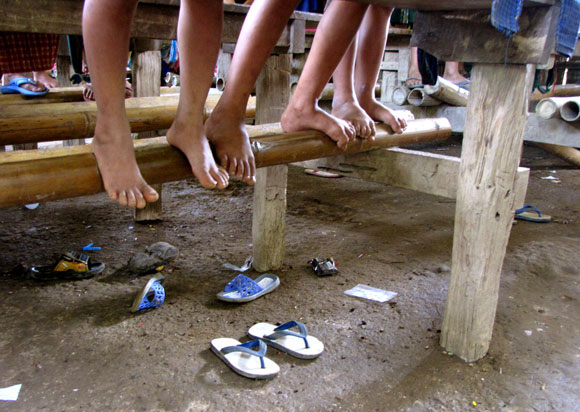
After an uneasy start in Utah, parents devastated by daughter's death
By Julia Lyon | The Salt Lake Tribune
At Mae La, Hser Ner Moo was her father’s shadow. When he put on his sandals, she put on hers, too. When he washed dishes in a plastic basin, she would help. He talked to her about why she should work hard in school, not dwelling on the family’s terrifying past in Burma.
Hser Ner Moo studied Karen, Burmese and English in Mae La’s open-air classrooms, where children sit on long bamboo benches, their flip-flops dangling over the hard-packed ground. She often played school, pointing to the letters of the alphabet with a stick. She wanted to be a teacher when she grew up.
In 2006, the U.S. invited thousands of Burmese refugees at Mae La to apply for resettlement. Cartoon and Pearlly signed up, believing America was going to save them. Their children would have a better education, and they would have the chance to work hard toward a house, a car, a more comfortable life.
But within weeks of their arrival in Utah in August 2007, Cartoon and Pearlly were confused.
They had been careful to ration the meat and rice provided by their resettlement agency, but now they were running low on food. They didn’t know how to find their resettlement caseworker, known by refugees as Mr. Tomorrow for his lack of follow-through. They couldn’t call for help because their phone wasn’t connected.
Desperate, Pearlly asked Granite School District refugee liaison Carrie Pender for help. She bought them groceries and set up their phone. A Mormon service missionary helped Cartoon and his older sons find jobs and brought the family winter coats and blankets as the weather turned colder.
As snow began to fall, amazing the family, Cartoon tasted the flakes. He realized the ice he had paid for in Thailand fell from the sky in Salt Lake City.
Hser Ner Moo, busy learning English in the second grade, again played teacher at home, showing her mother how to write “Hser Ner Moo” by scribbling it on a lamp shade. Eager to help, she told her mother not to be late for church and loved to greet people at the door.
Her family called her monkey: she was quick to mimic and invent mischief. Cartoon was finally able to buy her the bike she wanted: a pink one, from Walmart.
Weeks before she vanished, Hser Ner Moo learned how to ride that bike. One day in March 2008, she asked to talk on the phone to her cousin, Eh Thaw, who was still in Mae La. On the weekends, she had often visited his general store, where he gave her sweet plum paste and told her funny stories. She called him brother.
She told Eh Thaw how happy she was in America -- and that he should come, too.
A daughter lost » Esar Met was getting ready to come by himself to America in February 2008. His mother worried about her dependent son making the trip alone, but officials assured her the family would be sent to the same state. Refugees only resettle with their parents until they are 21.
Her cousin, Mi Cho, was already in Utah and offered to help take care of Esar until they arrived. Esar’s parents quickly followed with six of his younger siblings, all happy to be reunited.
They moved in across the parking lot from Hser Ner Moo’s family at South Parc, where Esar lived with roommates in an apartment children often visited to watch TV and listen to music.
Esar's family had arrived on March 25.
On March 31, Pearlly was leaving for a dentist appointment when Hser Ner Moo ran after her, reminding her mother to call 911 if she needed help.
Pearlly never saw her again.
A neighbor had seen Hser Ner Moo walk away from the family’s apartment around 2 p.m. When she hadn’t returned four hours later, Pender called police.
The next day, Esar’s apartment was the last in the complex police checked. FBI agents discovered her body when his roommates returned from work and let them in. The men told police about Esar, and officers quickly found him at Mi Cho’s home.
When they went to arrest him, he tried to run, but police say he later confessed. Prosecutors charged him with aggravated murder and child kidnapping.
The news stunned his mother, Ra He Mar. She had never seen her son be violent and didn’t understand why he was in jail. “I don’t know if he has done anything wrong,” she said. “Is it true he killed that person?”
Fearing revenge, concerned for their children’s safety, Esar’s family soon moved south to Arizona to start over once again.
After the murder, Pearlly and Cartoon yearned to see their daughter’s body, to learn for themselves what had happened to her. But an autopsy had to be performed. And protective friends wanted to shield them from a brutal sight.
Pearlly and Cartoon wanted to touch Hser Ner Moo, to bathe her, to dress her, to smooth on thanaka before her burial. But in American tradition, a funeral home neatly took over.
The embalmed girl in the casket didn’t look like Hser Ner Moo anymore.
Snow lingered on the Wasatch Mountains as Pearlly stood in a cold cemetery at her daughter’s funeral.
Refugee friends later told her the poor are often cremated in America. They asked her what she saw go into the ground.
Perhaps the stone only symbolized her daughter’s grave. She asked Cartoon whether it was real.
In America, he said, they wouldn’t lie.
Advance to the next chapter :: Return to the table of contents

 /a>
/a>









